聚合实施方法
3.聚合实施方法1
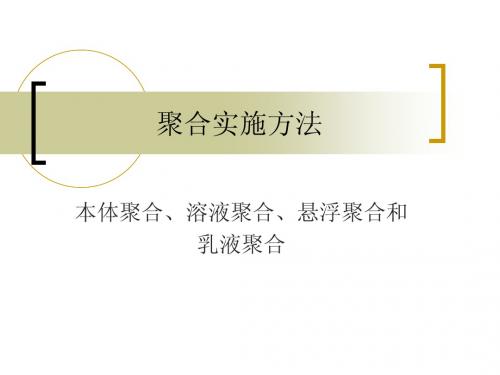
产品特性:分子量高达百万
高压聚乙烯—连续气相本体聚合
压力150~200MPa,温度180~200 ˚C,以 微量(10-6~10-4)氧为引发剂 一般在管式反应器中进行,停留时间只有几 分钟,单程转化率约15%~30% 产品特性:由于高温聚合因此有大量链转移 反应,造成主链上有大量的支链,密度 (0.91-0.93g/cm3)、结晶度(55-65%)、熔点 (105-110 ˚C)都较低。称作低密度聚乙烯 (LDPE),适合制造薄膜。
连续均相溶液聚合:以51-52%的硫氰化钠
(NaSCN)水溶液为溶剂,AIBN为引发剂,pH5±0.2, 温度75~85 ˚C,转化率70~75%。进料单体浓度 17%,出料聚合物浓度13%,脱除单体后直接用于纺 制腈纶纤维。
连续沉淀聚合:以水为溶剂,过硫酸盐类氧化
还原引发体系,温度40~50 ˚C,转化率80%。聚合 产物从反应体系中沉淀出来,经洗涤、分离、干燥后 重新配制成纺丝溶液用于腈纶纺丝。
聚合实施方法
本体聚合、溶液聚合、悬浮聚合和 乳液聚合
定义
本体聚合(Bulk Polymerization):在单体本身中加入少量引 发剂(甚至不加)进行的聚合反应。 溶液聚合(Solution Polymerization):将单体和引发剂溶解在 适当的溶剂中进行的聚合反应。 悬浮聚合(Suspension Polymerization):一般是将单体液滴 悬浮在水中进行的聚合,体系主要由水、单体、油溶性引发 剂、分散剂组成。也有将水性单体悬浮于油性溶剂中进行的 聚合,称反相悬浮聚合。 乳液聚合(Emulsion Polymerization):将单体在水中分散成 乳液状进行的聚合反应,体系由单体、水、水溶性引发剂、 水溶性乳化剂组成。
聚合实施方法

聚合实施方法第四章聚合实施方法4.1.本体聚合一.定义:不加其它介质,只有单体本身在印发剂、光、热辐射的作用下进行的聚合。
二.配方组成:单体+引发剂(或用光、热辐射引发)+(助剂,如少量颜料、增塑剂、润滑剂、分子量调节剂)三.分类:1.根据单体和聚合体的互溶情况分为均相和非均相两种。
均相本体聚合,是指聚合物溶于单体,在聚合过程中物料逐渐变稠,始终成为均一相态,最后变成硬块。
St、MMA的本体聚合就属均相本体聚合。
非均相本体聚合是单体聚合后新生成的聚合物不溶于单体中,从而沉淀下来成为异相,即非均相氯乙烯的本体聚合。
2.按参加反应的单体的相态分为气相和液相两种。
气相本体聚合最为成熟的是高压聚乙烯的生产。
典型的液相本体聚合有St、MMA 的本体聚合。
四.优缺点1.优点:生产流程短、设备少,易于连续化、生产能力大、产品纯度高、透明性好,此法适用于生产板材或其它型材。
2.缺点:①反应热大,不易排出,危险性大②由于反应体系粘度大,分子扩散困难,所以形成的聚合物分子量分布变宽。
五.聚合机理:遵循自由基聚合一般机理,提高反应速率时,往往分子量降低。
六.意义理论上:由于其组成简单、影响因素少,特别适用于实验室研究。
如:a.单体聚合能力的初步鉴定b.动力学研究c.竞聚率测定d.少量聚合物的试制实际生产上:许多单体均可采用本体聚合方法,不论是气体、液体或固体。
七.生产工艺特征关键是反应热的排出,△H=55~95KJ∕mol20%以下,体系粘度小,散热无困难30%以上,粘度大,散热不易,加上凝胶效应,放热更高,如果散热不良,轻者,造成局部过热,分子量分布变宽,影响产品质量;重者,温度失调,引起短聚,为解决此问题,在工艺和设备的设计上采取了多种措施:〈1〉使反应进行到一定转化率就分离出聚合物。
〈2〉采用较低的反应温度、较低浓度的引发剂进行聚合。
〈3〉将聚合分布进行,控制转化率“自动加速效应”,使放热均匀。
〈4〉强化聚合设备的传热。
第五章聚合方法

第五章聚合方法一、名称解释1. 自由基聚合实施方法(Process of Radical Polymerization):主要有本体聚合,溶液聚合,乳液聚合,悬浮聚合四种。
2. 离子聚合实施方法:主要有溶液聚合,淤浆聚合。
3. 逐步聚合实施方法:主要有熔融聚合,溶液聚合,界面聚合。
4. 本体聚合:本体聚合是单体本身、加入少量引发剂(或不加)的聚合。
5. 悬浮聚合:悬浮聚合一般是单体以液滴状悬浮在水中的聚合,体系主要由单体、水、油溶性引发剂、分散剂四部分组成。
6. 悬浮作用:某些物质对单体有保护作用,能降低水的表面张力,能使水和单体的分散体系变为比较稳定的分散体系,这种作用称为悬浮作用。
7. 本体聚合:本体聚合是单体本身、加入少量引发剂(或不加)的聚合。
8. 溶液聚合:是指单体和引发剂溶于适当溶剂的聚合。
9. 乳液聚合:是单体在水中分散成乳液状而进行的聚合,体系由单体、水、水溶性引发剂、水溶性乳化剂组成。
10. 分散剂:分散剂大致可分为两类,(1)水溶性有机高分子物,作用机理主要是吸咐在液滴表面,形成一层保护膜,起着保护人用,同时还使表面(或界面)张力降低,有利于液滴分散。
(2)不溶于水的无机粉末,作用机理是细粉吸咐在液滴表面,起着机械隔离的作用。
11. 乳化剂:常用的乳化剂是水溶性阴离子表面活性剂,其作用有:(1)降低表面张力,使单体乳化成微小液滴,(2)在液滴表面形成保护层,防止凝聚,使乳液稳定,(3)更为重要的作用是超过某一临界浓度之后,乳化剂分子聚集成胶束,成为引发聚合的场所。
12. 胶束:当乳化剂浓度超过临界浓度(CMC)以后,一部分乳化剂分子聚集在一起,乳化剂的疏水基团伸身胶束回部,亲水基伸向水层的一种状态。
13. 临界胶束浓度:乳化剂开始形成胶束时的浓度称为临界胶束浓度,简称CMC。
14. 亲水亲油平衡值(HLB):该值用来衡量表面活性剂中亲水部分和亲油部分对水溶性的贡献,该值的大小表表亲水性的大小。
聚合反应实施方法
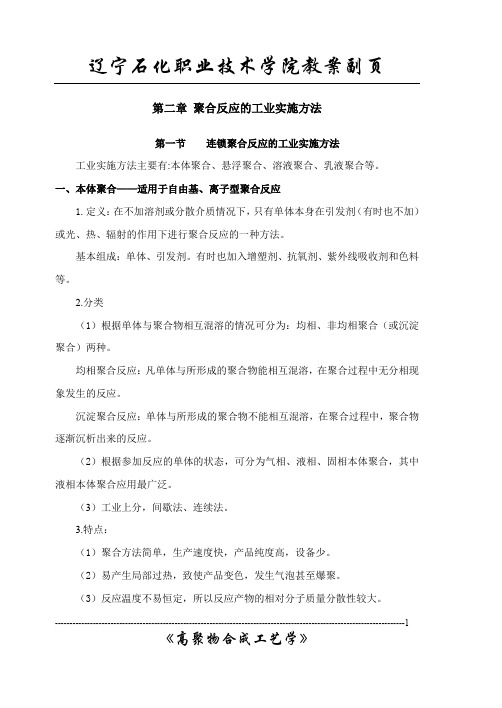
第二章聚合反应的工业实施方法第一节连锁聚合反应的工业实施方法工业实施方法主要有:本体聚合、悬浮聚合、溶液聚合、乳液聚合等。
一、本体聚合——适用于自由基、离子型聚合反应1.定义:在不加溶剂或分散介质情况下,只有单体本身在引发剂(有时也不加)或光、热、辐射的作用下进行聚合反应的一种方法。
基本组成:单体、引发剂。
有时也加入增塑剂、抗氧剂、紫外线吸收剂和色料等。
2.分类(1)根据单体与聚合物相互混溶的情况可分为:均相、非均相聚合(或沉淀聚合)两种。
均相聚合反应:凡单体与所形成的聚合物能相互混溶,在聚合过程中无分相现象发生的反应。
沉淀聚合反应:单体与所形成的聚合物不能相互混溶,在聚合过程中,聚合物逐渐沉析出来的反应。
(2)根据参加反应的单体的状态,可分为气相、液相、固相本体聚合,其中液相本体聚合应用最广泛。
(3)工业上分,间歇法、连续法。
3.特点:(1)聚合方法简单,生产速度快,产品纯度高,设备少。
(2)易产生局部过热,致使产品变色,发生气泡甚至爆聚。
(3)反应温度不易恒定,所以反应产物的相对分子质量分散性较大。
------------------------------------------------------------------------------------------------------------------------1《高聚物合成工艺学》(4)产品容易老化。
4.主要产品:PS树脂、PMMA树脂、PE树脂、PVC树脂等。
5.主要影响因素:(1)单体的聚合热会放出大量的热量,如何排除是生产中的第一个关键问题。
工业生产中:一般采用两段式聚合第一段在较大的聚合釜中进行,控制10%~40%以下转化率;第二段进行薄层(如板状)聚合或以较慢的速度进行。
(2)聚合产物的出料是本体聚合的第二个问题,控制不好不但会影响产品的质量,还会造成生产事故。
解决办法:根据产品特性,选出料方式浇铸脱模制板材或型材,熔融体挤出造粒,粉状出料。
聚合反应的实施方法

聚合反应的实施方法以下是 6 条关于聚合反应实施方法的内容:1. 嘿,你知道吗,温度可是聚合反应的关键一环啊!就好比烤蛋糕,温度不对,那蛋糕可就不松软好吃啦!比如说在自由基聚合反应里,控制好合适的温度能让反应顺顺利利进行。
要是温度太高,那不就跟火上浇油似的,反应可能失控哦!而温度太低,反应又会慢吞吞的,急死人啦!所以,可得好好把握这个温度呀!2. 自由基引发剂这玩意儿可重要啦!就像一场比赛中的发令枪响一样。
比如在某些聚合反应中,没有合适的引发剂,那反应就很难启动起来呀!这就好比汽车没有钥匙,怎么发动呀?有了好的引发剂,才能让聚合反应迅速起跑,一路向前冲呢!这可不是开玩笑的哟!3. 单体的纯度啊,那可太重要咯!你想想,如果单体里面有杂质,那不就像米饭里有沙子一样咯牙嘛!例如在做聚合反应时,单体不纯可能导致反应乱七八糟的,结果一塌糊涂呀!所以,在进行聚合反应之前,一定要确保单体纯净纯净再纯净呀,这可不能马虎哟!4. 反应时间也得拿捏好呀!你看哈,时间太短,反应可能还没完成,那多可惜呀!这不就跟跑步比赛还没到终点就停下一样嘛。
但要是时间太长呢,又浪费时间和精力啦!就像煮汤,时间太久汤都煮干咯!所以呀,要找到那个刚刚好的反应时间,才能收获完美的聚合反应结果哟!5. 搅拌也别小瞧呀!这就好像给反应来个大保健一样。
没有适当的搅拌,反应物们都不能好好混合呀,那不就跟一群人各玩各的没啥交流一样嘛。
比如在一些聚合反应中,好好搅拌能让反应更均匀,效果更好嘞!可别小看这一搅拌哦!6. 环境也很关键呐!这就好比鱼需要干净的水才能快活地游。
要是聚合反应的环境不合适,那反应也会受影响呀!比如湿度太大或者有杂质啥的,那可得小心咯!所以啊,给聚合反应创造一个舒适的环境真是太重要啦!我觉得啊,聚合反应的实施方法真的是每一个细节都不能马虎,都得认真对待,这样才能得到。
逐步聚合实施方法
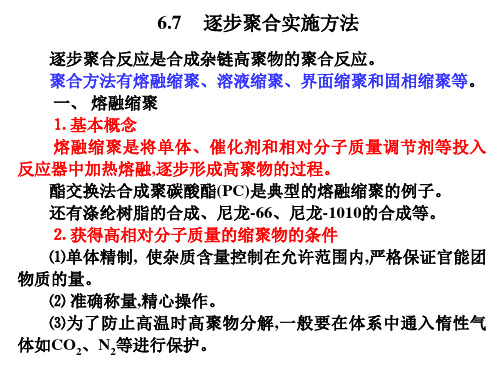
三、 界面缩聚 ⒈ 基本概念
将两种单体分别溶于两种互不相溶的溶剂中 形成两种单 将两种单体分别溶于两种互不相溶的溶剂中,形成两种单 在两种溶液的界面处进行缩聚反应, 体溶液 ,在两种溶液的界面处进行缩聚反应,并很快形成聚 合物的这种缩聚称为界面缩聚。 合物的这种缩聚称为界面缩聚。 在实验室中把己二酰氯溶于三氯甲烷中, 在实验室中把己二酰氯溶于三氯甲烷中 把己二胺溶于水中(水呈碱性 以吸收反应中生成的氯化氢 把己二胺溶于水中 水呈碱性,以吸收反应中生成的氯化氢 水呈碱性 以吸收反应中生成的氯化氢),
苯核和羰基对分子刚性的影响超过醚键对分子柔性的影 苯核和羰基对分子刚性的影响超过醚键对分子柔性的影 因而PC分子的刚性还是相当大的 致使PC的玻璃化温度较 响,因而 分子的刚性还是相当大的 致使 的玻璃化温度较 因而 分子的刚性还是相当大的,致使 分子间的作用力很大。 高,Tg=145℃~150℃,PC分子间的作用力很大。 ℃ ℃ 分子间的作用力很大 刚性分子链彼此缠绕,不易解除 不易解除,使分子间相对滑移比较 刚性分子链彼此缠绕 不易解除 使分子间相对滑移比较 困难,因此 的熔点也较高, 因此PC的熔点也较高 困难 因此 的熔点也较高 Tm=220℃~230℃。 ℃ ℃ 异丙撑基使PC形成稳定的二次结构 形成稳定的二次结构——原纤维状结构 异丙撑基使 形成稳定的二次结构 原纤维状结构 (完全伸展的分子链组成的纤维状晶体 。 完全伸展的分子链组成的纤维状晶体)。 完全伸展的分子链组成的纤维状晶体 原纤维状结构混乱交错在一起组成疏松的网络,使高聚物 原纤维状结构混乱交错在一起组成疏松的网络 使高聚物 中存在着大量的微空隙, 从而具有很高的冲击韧性。 中存在着大量的微空隙 从而具有很高的冲击韧性。 聚碳酸酯的性能可归纳为下列几点。 聚碳酸酯的性能可归纳为下列几点。 外观:由于合成PC时催化剂不同 时催化剂不同,PC显示不同的颜色。 显示不同的颜色。 外观:由于合成 时催化剂不同 显示不同的颜色 用三乙胺做催化剂时产品为白色透明的树脂(或略带微 用三乙胺做催化剂时产品为白色透明的树脂 或略带微 黄色); 黄色 ; 用苯甲酸做催化剂时,产品为浅红色 产品为浅红色; 用苯甲酸做催化剂时 产品为浅红色;用醋酸锂作催化剂 产品为浅紫色; 产品为暗紫色。 时,产品为浅紫色;用醋酸钴作催化剂时 产品为暗紫色。 产品为浅紫色 用醋酸钴作催化剂时,产品为暗紫色
逐步聚合主要实施方法

逐步聚合主要实施方法在进行文库项目的写作过程中,实施方法的逐步聚合是至关重要的。
这一过程包括从确定主题和目的开始,逐步发展结构、撰写内容直至最终完善。
下面将介绍一些主要的实施方法,以帮助您在文库项目中取得成功。
确定主题和目的在开始撰写文库项目之前,首先需要明确项目的主题和写作目的。
主题是文库内容的核心,而写作目的则是告诉读者你为什么选择这个主题以及你希望读者从中获得什么信息。
通过确立清晰的主题和目的,可以帮助文库内容更具针对性和连贯性。
制定大纲一旦主题和目的确定,接下来就是制定文库的大纲。
大纲是文库结构的框架,可以帮助你合理组织思维,确保内容的逻辑性和连贯性。
大纲应包括引言、正文和结论等部分,每部分又可进一步细分,以便更好地展开论述。
搜集资料在编写文库时,搜集资料是至关重要的一环。
通过查阅书籍、学术论文、互联网资料等多种来源,可以为文库内容提供充足的依据和支撑。
在搜集资料的过程中,务必注意对信息的筛选和分析,确保所引用的内容准确可靠。
撰写内容在完成资料搜集后,就可以开始撰写文库的内容了。
在写作过程中,要确保语言表达清晰简洁、逻辑严谨。
可以通过段落结构和过渡句等手段,将各部分内容有机地连接起来,使整个文库看起来更加连贯和流畅。
修改和完善一篇优秀的文库离不开反复修改和完善。
在初稿完成后,要仔细审查文库内容,检查语言是否通顺、内容是否合理。
可以邀请他人给予意见和建议,以便发现不足之处并加以改进。
通过不断修改和完善,可以使文库内容更加精炼和完整。
结语通过以上逐步聚合的主要实施方法,您可以更好地完成文库项目的写作。
在整个过程中,要始终保持耐心和专注,不断反思和调整写作方向,最终呈现一篇内容丰富、结构合理的文库作品。
希望这些方法对您有所帮助,祝您的文库项目取得成功!。
4 聚合实施方法

(2) 引发剂 一般根据单体和工艺条件,在油溶性的偶 氮类和有机过氧化物中选择单一型或复合型引 发剂。
使用时,先将引发剂溶解于单体中,然后 在搅拌下加入水相,升至预定温度,进行聚合 。但氯乙烯进行悬浮聚合时有所不同,是将引 发剂先加入溶有分散剂的水相中,最后加入单 体,在搅拌的作用下,引发剂通过水相扩散到 单体液滴中引发聚合。苯乙烯的悬浮聚合可以 不加引发剂,直接进行加热,引发聚合。
(NH4)2S2O8
回流
回流
丙烯腈在二甲基甲酰胺DMF中聚合—纺丝液 (干法纺丝)
丙烯腈在硫氰酸钠水溶液中聚合 —纺丝液 (湿法纺丝) 乙酸乙烯酯在甲醇中聚合,进一步醇解制备 聚乙烯醇PVA 丙烯酸酯类在乙酸乙酯中的聚合—涂料 溶液聚合在实验室使用较多,可用于研究聚 合反应动力学,选用CS小的溶剂进行溶液聚合可 以消除自动加速效应,有利于研究各种动力学参 数之间的定量关系。
合成高分子
含羧基 含氮 含酯基 天然硅酸盐
硫酸盐
非水溶性 无机分散剂 无机粉末 碳酸盐 磷酸盐 草酸盐 氢氧化物 氧化物
硫酸钙,硫酸钡
碳酸钙、碳酸钡、碳酸镁 磷酸钙 草酸钙 氢氧化铝、氢氧化镁 二氧化钛、氧化锌
3.3.3 单体液滴与聚合物粒子的形成过程
1. 单体液滴的形成过程 将溶有引发剂的油状单体倒入水中,油状单 体浮于水面上,聚合体系形成两层。 搅拌时,在剪切力作用下,单体液层先被拉 成细条形,然后分散成液滴。大液滴受力,还会 变形,分散成小液滴。由于单体和水的两相之间 存在一定的界面张力,使液滴力图保持球形。界 面张力愈大,保持成球形的能力愈强,形成的液 滴也愈大。反之,界面张力愈小,形成的液滴也 愈小。分散剂的作用是降低两相间的界面张力协 助搅拌使单体液滴变小。
高分子材料基础-聚合实施方法

定义:
组分:
优点:
缺点:
液液分散和成粒过程
分散剂、搅拌
在一定搅拌强度和界面张力下,液滴通过一系列分散、合并过程,构成动平衡,最后达到一定的平均细度。
分散剂类型: 1)水溶性有机高分子:吸附在液滴表面,形成保护膜。 主要有聚乙烯醇等合成高分子,及纤维素衍生物、明胶等天然高分子及其衍生物。多采用质量稳定的合成高分子。 2)不溶于水的无机粉末:包围液滴,起机械隔离作用。主要有碳酸镁、滑石粉、高岭土等。
亲水的极性基团
亲油的非极性基团
乳化剂组成
乳化剂浓度很低时,以分子状态溶于水中;
乳化剂的溶解过程:
临界胶束浓度(Critical Micelle Concentration)(CMC)
浓度达到一定值后,乳化剂分子形成胶束。
在乳化剂水溶液中,单体除了以分子状态真正溶于水中外, 还可以较多的溶解于胶束内----增溶作用
极大部分聚合发生在胶束内。
引发剂溶于水,分解产生自由基,在何种场合引发聚合?
水相:水中溶解的单体可以进行聚合,但水相中单体浓度极低。
单体液滴内:由于引发剂是水溶性的,单体液滴内无引发剂,自由基不能扩散进入单体液滴引发聚合,且单体液滴体积大,比表面积小。
乳液聚合根据乳胶粒的数目、单体液滴是否存在,分为三阶段:
丁苯橡胶 丙烯酸酯类
01
02
03
01
02
聚合过程
第Ⅰ阶段
成核期: 从引发至胶束消失。 特点:体系中含单体液滴、胶束、乳胶粒; 乳胶粒数↑,单体液滴数〓,但体积减小,Rp↑ 。 未成核的胶束全部消失为此阶段结束的标志。
第Ⅱ 阶段
恒速期: 自胶束消失始至单体液滴消失止。
第5章 聚合方法
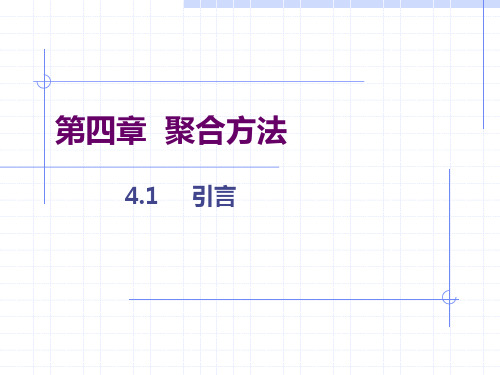
C、出现凝胶效应,放热速率提高。 此时如散热不良,轻则造成局部过热, 使分子量分布变宽,最后影响到聚合物的 机械强度;重则温度失控,引起爆聚。
表4-3 本体聚合工业生产举例
聚合物 过程要求 聚甲基丙烯酸甲酯 第一阶段预聚至约10%转化率的粘稠浆液, (有机玻璃板) 然后浇模分段升温聚合,最后脱模成板材 聚苯乙烯 第一阶段:80~85℃预聚至33%~35%转化率, 然后在100~220℃温度递增的条件下聚合, 最后熔体挤出造粒 第一阶段预聚至7%-11%转化率,形成颗粒骨 架,然后在第二反应器内继续沉淀聚合,最 后以粉状出料 选用管式或釜式反应器连续聚合,控制单程 转化率15%-30%,最后熔体挤出造粒,未反 应单体经精制后循环使用
第四章
聚合方法
4.1 引言
1、自由基聚合的四种实施方法:
本体聚合、溶液聚合、悬浮聚合、乳液聚合
2、离子聚合的实施方法: 溶液聚合、淤浆聚合
3、逐步聚合(缩聚)实施方法: 本体聚合、溶液聚合以及界面聚合
均相体系:本体、溶液
从工程角度:
非均相体系:悬浮、乳液
例如: PS——均相体系 PVC——非均相体系
(MMA沸点为100.5℃)
高温热处理阶段——转化率达90%以后,进一步 升温至PMMA玻璃化温度以上(例如100-120℃) 进行高温热处理,使残余单体充分聚合。 高温聚合结束——冷却、脱模、修边,即成有机 玻璃板成品。 这样由本体浇铸聚合法制成的有机玻 璃,分子量可达106,而注射用的悬浮法 PMMA分子量一般约5-l0万。
缺点: ①单体浓度较低,聚合速率较慢,生产效 率较低; ②聚合物分子量降低 ;(单体浓度低和向溶剂链
转移的结果)
③溶剂回收代价大; ④除尽聚合物中残留溶剂困难。
逐步聚合实施方法_四种

逐步聚合实施方法四种
在实施项目或计划时,逐步聚合实施方法是一种旨在逐步完善和推进项目的方法。
这种方法可以帮助项目团队更有效地管理和控制项目,确保项目目标得以实现。
下面将介绍四种常见的逐步聚合实施方法,供大家参考。
1. 渐进模糊
渐进模糊是一种逐步聚合实施方法,其核心理念是在项目初始阶段允许一定程度的模糊和不确定性,随着项目的推进逐渐减少这种模糊性。
这种方法能够充分适应项目需求的变化和复杂性,同时也能够让项目团队更灵活地应对变化和挑战。
2. 迭代增量
迭代增量是另一种常见的逐步聚合实施方法,项目团队将项目划分为多个迭代周期,每个迭代周期都会交付一定的成果和价值。
通过多次迭代,项目逐步完善并实现项目目标。
这种方法能够帮助团队及时发现和纠正问题,提高项目的成功率和质量。
3. 敏捷开发
敏捷开发是一种注重灵活性和快速响应变化的逐步聚合实施方法,团队通过短周期的迭代开发来不断调整和优化产品。
敏捷开发强调与客户的紧密合作和需求的变化响应,能够有效减少不必要的工作,提高项目交付的价值和客户满意度。
4. 螺旋模型
螺旋模型是一种风险驱动的逐步聚合实施方法,项目团队在每个阶段均考虑风险,并采取相应的措施来管理和降低风险。
螺旋模型将项目划分为多个循环,每个循环都会逐步完善和调整项目计划,以确保项目的成功实施。
综上所述,逐步聚合实施方法是一种有效管理项目的方式,能够帮助项目团队灵活应对变化,减少风险,提高项目成功的几率。
不同的方法适用于不同的项目和团队,项目经理应根据实际情况选择合适的方法来推进项目。
希望以上内容对大家有所帮助!
1。
连锁聚合实施方法有哪些
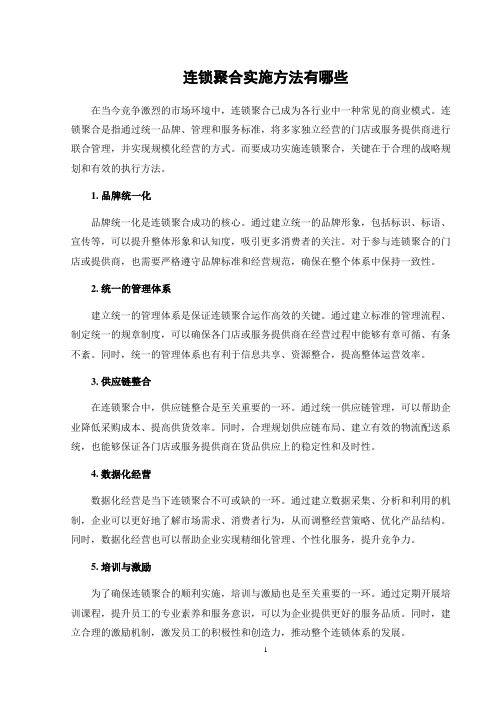
连锁聚合实施方法有哪些在当今竞争激烈的市场环境中,连锁聚合已成为各行业中一种常见的商业模式。
连锁聚合是指通过统一品牌、管理和服务标准,将多家独立经营的门店或服务提供商进行联合管理,并实现规模化经营的方式。
而要成功实施连锁聚合,关键在于合理的战略规划和有效的执行方法。
1. 品牌统一化品牌统一化是连锁聚合成功的核心。
通过建立统一的品牌形象,包括标识、标语、宣传等,可以提升整体形象和认知度,吸引更多消费者的关注。
对于参与连锁聚合的门店或提供商,也需要严格遵守品牌标准和经营规范,确保在整个体系中保持一致性。
2. 统一的管理体系建立统一的管理体系是保证连锁聚合运作高效的关键。
通过建立标准的管理流程、制定统一的规章制度,可以确保各门店或服务提供商在经营过程中能够有章可循、有条不紊。
同时,统一的管理体系也有利于信息共享、资源整合,提高整体运营效率。
3. 供应链整合在连锁聚合中,供应链整合是至关重要的一环。
通过统一供应链管理,可以帮助企业降低采购成本、提高供货效率。
同时,合理规划供应链布局、建立有效的物流配送系统,也能够保证各门店或服务提供商在货品供应上的稳定性和及时性。
4. 数据化经营数据化经营是当下连锁聚合不可或缺的一环。
通过建立数据采集、分析和利用的机制,企业可以更好地了解市场需求、消费者行为,从而调整经营策略、优化产品结构。
同时,数据化经营也可以帮助企业实现精细化管理、个性化服务,提升竞争力。
5. 培训与激励为了确保连锁聚合的顺利实施,培训与激励也是至关重要的一环。
通过定期开展培训课程,提升员工的专业素养和服务意识,可以为企业提供更好的服务品质。
同时,建立合理的激励机制,激发员工的积极性和创造力,推动整个连锁体系的发展。
综上所述,要实现连锁聚合的成功运作,需要在品牌统一化、管理体系、供应链整合、数据化经营、培训与激励等方面做到位。
只有通过综合性的战略规划和有效的执行方法,企业才能在激烈的市场竞争中取得领先优势,实现长期稳健的发展。
逐步聚合的实施方法有哪些各自特点如何实现

逐步聚合的实施方法有哪些各自特点如何实现随着社会的不断发展,逐步聚合的实施方法在不同领域得到了广泛应用。
逐步聚合是指通过逐步将各个分散的元素或资源聚集在一起,最终形成一个整体的过程。
在实际运用中,逐步聚合的实施方法包括但不限于以下几种方式,并且每种方式都有其独特的特点和实现方式。
1. 逐步聚合的实施方法之一:递进式聚合递进式聚合是指逐步将各个分散的元素或资源按照一定的顺序逐步聚合在一起。
其特点在于每一步的聚合都依赖于前一步的结果,通过不断迭代实现整体的聚合。
递进式聚合的实现方式通常通过分阶段的计划和执行,确保每个阶段都能顺利完成并为下一阶段的聚合提供支持。
2. 逐步聚合的实施方法之二:并行式聚合并行式聚合是指同时进行多个分散元素或资源的聚合,通过并行的方式加快整体的聚合过程。
其特点在于各个聚合子任务之间相对独立,可以同时进行而互不影响。
实现并行式聚合的关键在于合理规划各个子任务的执行顺序和资源分配,确保每个子任务都能顺利完成并将结果合并为整体。
3. 逐步聚合的实施方法之三:递归式聚合递归式聚合是指通过不断重复相同的聚合过程,逐步将所有分散的元素或资源聚合为一个整体。
其特点在于每一次聚合都涵盖了之前所有的聚合结果,通过逐级扩大的方式实现最终的整体聚合。
实现递归式聚合的关键在于确定递归的停止条件和每一级聚合的操作方法。
4. 逐步聚合的实施方法之四:迭代式聚合迭代式聚合是指通过反复迭代的方式逐步优化和完善各个分散元素或资源的聚合结果。
其特点在于每一轮迭代都围绕特定的目标或问题进行,通过不断调整和改进实现整体的聚合。
实现迭代式聚合的关键在于设定清晰的迭代目标和监控机制,确保每一轮迭代都能取得可衡量的结果。
综上所述,逐步聚合的实施方法包括递进式聚合、并行式聚合、递归式聚合和迭代式聚合等多种方式,每种方式都有其独特的特点和实现方法。
在实际应用中,可以根据具体的需求和情况选择合适的聚合方法,并结合实际情况进行灵活应用,从而实现高效的资源整合和优化的结果。
《高分子化学》教案第4章自由基聚合实施

第四章自由基链式聚合实施方法本章要点:1.自由基链式聚合的实施:通常有本体聚合、溶液聚合、悬浮聚合和乳液聚合,它们有不同的适用场合,有着各自的优缺点;2.本体聚合:为解决散热问题,采用分段聚合;3.溶液聚合:溶剂的选择性是关键;4.悬浮聚合:聚合机理同常规的本体或溶液聚合,分散剂起到关键作用,产物的粒径达到mm级;5.乳液聚合:具有特殊的聚合机理和聚合规律,通过增加乳化剂用量可同时提高聚合速率和产物的分子量;6.大品种高分子:低密度聚乙烯、聚苯乙烯、聚甲基丙烯酸甲酯、聚乙酸乙烯酯和丁苯橡胶等等,宜采取适当方法生产。
本章难点:1.乳液聚合的聚合场所:增溶胶束和乳胶粒为乳液聚合的主要差所;2.乳液聚合的聚合过程:根据聚合速率,乳液聚合分为三个阶段;聚合过程中单体和乳化剂的物料转移由单体液滴、至水相、再至乳胶粒;聚合过程中分散相(胶束、单体液滴和乳胶粒)按一定规律变化;3.乳液聚合动力学:经典的乳液聚合包含许多理想条件。
4.1 聚合方法和聚合体系4.1.1 单体在反应介质中的分散状态本体聚合没有反应介质,溶液聚合中单体以分子状态溶解在反应介质,悬浮聚合中单体以mm级的分散相悬浮于反应介质中,在乳液聚合中单体主要存在于分散相的单体液滴和乳胶粒中。
4.1.2. 按聚合体系的相态单体及其聚合物以分子状态溶解在反应介质中,聚合体系成为一相,此时为均相聚合;反之,单体或/和聚合物不溶于反应介质,聚合体系具有多个相,此时为非均相聚合。
4.1.3. 按单体的物理状态分类分为气相聚合、液相聚合和固相聚合。
4.2 本体聚合4.2.1 本体聚合的组成和特点本体聚合体系由单体、引发剂和少量助剂组成。
除用引发剂进行聚合以外,还可用光和辐照来进行聚合。
本体聚合的聚合速率高,产物纯度大,但是散热和搅拌困难。
4.2.2 本体聚合的适用场合产物纯度高,特别适用于生产板材和型材等透明制品,且所用设备比较简单。
本体聚合反应,也特别适合于实验室研究。
连锁聚合实施方法有哪些类型和特点

连锁聚合实施方法有哪些类型和特点在连锁经营领域,聚合实施方法是一种常见的策略,以便将多家连锁店或分店有效整合和管理,以实现整体效益最大化。
聚合实施方法包括几种类型,每种类型都有其各自的特点和适用场景。
类型一:标准化聚合标准化聚合是指通过制定统一的规范和流程,将各家连锁店的运营管理方式标准化以达到一致性。
这种类型的聚合实施方法具有操作简单、管理效率高的特点,能够确保品牌形象和服务质量的一致性。
适合于产业链较长、规模较大的连锁企业。
类型二:定制化聚合定制化聚合则是根据各家连锁店的特点和定位,为其量身定制适合自身特色的管理方案。
这种方法要求针对每家店铺的实际情况进行个性化调整,以确保整体管理策略更贴近实际需求。
定制化聚合的特点是灵活性强、能够更好地满足市场需求,适用于行业竞争激烈、消费者需求多样化的连锁店。
类型三:信息化聚合信息化聚合指通过引入先进的信息技术和系统,实现各家连锁店之间的信息共享和数据整合,从而提升管理效率和决策精度。
这种方法的特点是实时性强、管理便捷,有利于快速响应市场变化和管理需求。
信息化聚合适用于追求高效管理和数据分析的现代连锁企业。
类型四:人力资源聚合人力资源聚合是将各家连锁店的人力资源整合起来,通过统一的培训计划和人才选拔机制,提升员工素质和整体绩效水平。
这种方法的特点是人才流动性高、人力资源优化效果显著,有助于打造高效团队和稳定的员工队伍。
人力资源聚合适用于强调员工素质和服务质量的连锁企业。
不同类型的聚合实施方法各有侧重点和适用场景,连锁企业可以根据自身发展阶段和经营需求选择合适的方法进行实施。
综合考虑企业规模、行业特点和管理目标,合理运用聚合方法,有助于提升连锁店整体管理水平和竞争力,实现经营效益的最大化。
- 1、下载文档前请自行甄别文档内容的完整性,平台不提供额外的编辑、内容补充、找答案等附加服务。
- 2、"仅部分预览"的文档,不可在线预览部分如存在完整性等问题,可反馈申请退款(可完整预览的文档不适用该条件!)。
- 3、如文档侵犯您的权益,请联系客服反馈,我们会尽快为您处理(人工客服工作时间:9:00-18:30)。
4.5.2 Application of emulsion polymerization
(1)聚合后分离橡胶状或粉体的产品,如:丁苯橡胶(SBR)、丁腈橡 胶(NBR)、氯丁橡胶(CR)等合成橡胶,ABS、MBS等工程塑料,糊状 PVC、聚四氟乙烯(PTFE)等; (2)聚合后胶乳直接用作涂料和粘合剂的场合,如:丁苯胶乳、丙烯酸 胶乳、醋酸乙烯胶乳;
Shortcomings:
(1) low concentration of monomer, slow rate of polymerization, low utilization ratio of production facility; (2) chain transfer to solvent, low molecular weigh, (3) the purity of the polymer may be affected if there are difficulties in removal of the solvent.
Vinyl chloride Styrene-methyl alcohol Acrylic acid-hexane Acrylonitrile-water Vinyl chloride Vinylidine chloride Vinyl chloride
heterogeneous
Suspension Emulsion
13
4.5.3 Components The main components are the monomer(s), dispersing medium, emulsifier, and water-soluble initiator.
monomer: water-insoluble or slightly water-soluble, dispersing medium: the liquid, usually water, emulsifier: usually anionic surfactants water-soluble initiator: such as potassium or ammonium persulfate
heterogeneous polymerization system
根据聚合物在其单体或聚合溶剂中的溶解性能,则本体聚合、溶液聚 合和悬浮聚合都有均相聚合和非均相聚合之分。 2
Table 4.1 Polymerization Process Conditions
Monomermedium homogeneous Polymerization method Bulk (Mass) Gas Liquid Solid Solution Polymer-monomer (solvent) homogeneous Ethylene Styrene, Acrylate Styrene-benzene Acrylic acid-water Acrylonitrile-DMF Styrene Methyl methacrylate Styrene, Butadiene heterogeneous
不加任何溶剂,加入或不加引发剂,用热、光辐射等方法进行聚合。
(2)Solution Polymerization 溶液聚合;
将单体和引发剂溶于适当的溶剂中进行聚合。
(3)Suspension Polymerization 悬浮聚合;
单体液滴悬浮于水中。
(4)Emulsion Polymerization 乳液聚合。
Advantages: (1)The physical state of the emulsion system makes it easy to control the process.
(2)Being able to simultaneously attain both high molecular weights and high reaction rates. (3)The product can in many instances be used directly without further separations. Shortcoming:
3
4.2 Bulk (Mass) Polymerization
不加任何溶剂(介质),只有单体本身在引发剂、热、光辐射等的作用 下进行的聚合,称为本体聚合(Bulk Mass Polymerization)。 实际生产中,往往还加入少量的色料、增塑剂、分子量调节剂等助剂。
Advantages:
Bulk or mass polymerization of a pure monomer offers the simplest process with a minimum of contamination of the product. So it is especially fit for the preparation of transparent product. Shortcoming: (1) heat dissipation is difficult, (2) local hot spots may occur, (3) molecular weight distribution is broadened. 自由基聚合、离子聚合、缩聚都可选用本体聚合,气态、液态、固态单 体均可进行本体聚合,其中以液态单体的本体聚合最重要。
苯乙烯和甲基丙烯酸甲酯的悬浮聚合属均相聚合; 氯乙烯的悬浮聚合属沉淀聚合。
悬浮聚合产物的粒径在0.01-5mm之间,一般为0.05-2mm,随搅拌强度和分 散剂性质、用量而定。
8
悬浮聚合的液-液分散过程
停止搅拌 搅拌强度越大,液 滴越小,聚合生成的树 脂粒子越小
9
分散剂的作用机理:
(1)water-soluble polymers:吸附在液滴的表面,形成一层保护膜,起 到保护胶体的作用,同时使表面张力降低,有利于液滴分散; (2)water-insoluble inorganic compounds:(如:碳酸镁,碳酸钙、滑石粉 等):细小粉末吸附在液滴表面,起机械隔离的作用。
Chapter 4. Polymerization Method
(聚合实施方法)
1
4.1 Introduction
Free radical polymerization has four main polymerization methods: (1)Bulk Polymerization 本体聚合 ;
80-85%的PVC、苯乙烯离子交换树脂母体、很大一部分PS、PMMA采用 悬浮法生产。
11
4.5 Emulsion Polymerization
单体在水中由乳化剂分散成乳液状态进行的聚合,称为乳液聚合。
4.5.1 Characteristics of emulsion polymerization
10
Advantages
(1)体系粘度低,聚合热容易带走,散热和温度控制比本体聚合、溶液 聚合容易; (2)产物分子量及其分布稳定,分子量比溶液聚合的高; (3)产物分离的后处理工序比溶液聚合、乳液聚合容易。 Shortcoming 产物中多少带有少量分散剂残留物,要生产透明和绝缘性高的产品, 须将这些残留的分散剂除尽。 悬浮聚合在工业上应用广泛:
4
Utility:
In industry, bulk polymerization can be carried out continuously or in stages. The key problem is the heat dissipation. Bulk polymerization is not used commercially for chain polymerizations nearly as much as for step polymerizations because of the difficulties indicated. It is, however, used in the polymerizations of ethylene, styrene, and methyl methacrylate.ons under which radical polymerizations are carried out are of both the homogeneous and heterogeneous: Bulk Polymerization, Solution Polymerization -> homogeneous polymerization system; Suspension Polymerization, Emulsion Polymerization ->
6
Utility:
工业上溶液聚合多用于聚合物溶液直接使用的场合,如:涂料、胶 粘剂、浸渍剂、合成纤维纺丝等。
7
4.4 Suspension Polymerization
Suspension polymerization is carried out by suspending the monomer (discontinuous phase) as droplets (50–500 mm in diameter) in water (continuous phase). The main components are the monomer(s), oil-soluble initiator. water and suspension stabilizers. The monomer suspending as droplets are prevented from coalescing by agitation and the presence of suspension stabilizers. Each monomer droplet in a suspension polymerization is considered to be a miniature bulk polymerization system. The kinetics of polymerization within each droplet are the same as those for the corresponding bulk polymerization. 悬浮聚合的反应机理与本体聚合相似,有均相聚合和沉淀聚合之分。
